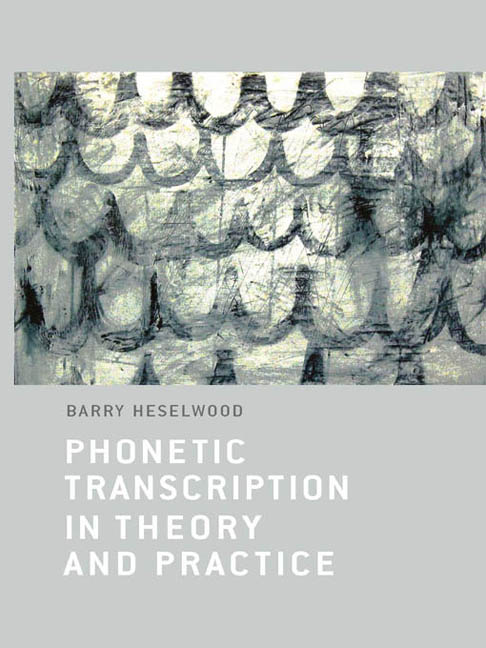Book contents
- Frontmatter
- Contents
- List of Tables
- List of Figures
- Preface
- Acknowledgements
- Introduction
- 1 Theoretical Preliminaries to Phonetic Notation and Transcription
- 2 Origins and Development of Phonetic Transcription
- 3 Phonetic Notation
- 4 Types of Transcription
- 5 Narrow Impressionistic Phonetic Transcription
- 6 Phonetic Transcription in Relation to Instrumental and Other Records
- 7 Uses of Phonetic Transcription
- Glossary
- References
- Appendix: Phonetic Notation Charts
- Index
6 - Phonetic Transcription in Relation to Instrumental and Other Records
Published online by Cambridge University Press: 07 December 2017
- Frontmatter
- Contents
- List of Tables
- List of Figures
- Preface
- Acknowledgements
- Introduction
- 1 Theoretical Preliminaries to Phonetic Notation and Transcription
- 2 Origins and Development of Phonetic Transcription
- 3 Phonetic Notation
- 4 Types of Transcription
- 5 Narrow Impressionistic Phonetic Transcription
- 6 Phonetic Transcription in Relation to Instrumental and Other Records
- 7 Uses of Phonetic Transcription
- Glossary
- References
- Appendix: Phonetic Notation Charts
- Index
Summary
Introduction
Although experimental phonetics using specially designed technological devices dates back to the early nineteenth century and had made sophisticated advances in the work of Rousselot, Scripture and Panconcelli-Calzia by the late nineteenth and early twentieth centuries, the necessary equipment was only available to very small numbers of researchers. The situation remained like this until the second half of the twentieth century. The first instrument to make a huge impact on phonetic research was the sound spectrograph, developed at the Bell Telephone Laboratories in the US, which started to become publicly available in the late 1940s (Koenig, Dunn and Lacy 1946), enabling precise measurements to be made on broad-band spectrograms of such key acoustic properties as vowel formant resonances, fricative spectra, and vowel and consonant durations, and measurements of F0 on narrow-band spectrograms. Never before had these phenomena been made so readily visible and quantifiable to phoneticians. But it is since the late 1980s or so that instrumental means of investigating the phonetic structure of speech have become much more widely accessible, as part of the ‘digital revolution’ in computer technology and its applications. In addition to spectrography, we now have computerised instruments that reveal articulatory activities, such as palatography, articulography, laryngoscopy, laryngography and ultrasound imaging. Information gained in these ways can be displayed for all who have sufficient phonetic training to see and interpret. Unsurprisingly, these new windows onto the objective properties of speech have had the effect of relegating auditory-perceptual analysis from the league of scientific methods, and either making phonetic transcription obsolete or co-opting it as a means of representing the results of instrumental analysis. Instrumental information quickly came to be seen as a means of checking the validity of auditory-perceptual analyses, on the assumption that the objects of instrumental and auditory-perceptual analyses are the same. After looking at how phonetic transcription can be used in the service of instrumental analyses, I shall, on the back of the case presented in Chapter 5 for the value of impressionistic phonetic transcription, argue that this assumption is misconceived, and that impressionistic transcription and instrumental records have a complementary relationship rather than a competitive one (Howard 2011: 135).
- Type
- Chapter
- Information
- Phonetic Transcription in Theory and Practice , pp. 223 - 250Publisher: Edinburgh University PressPrint publication year: 2013



